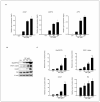Difenoconazole Induced Damage of Bovine Mammary Epithelial Cells via ER Stress and Inflammatory Response
- PMID: 39451231
- PMCID: PMC11506304
- DOI: 10.3390/cells13201715
Difenoconazole Induced Damage of Bovine Mammary Epithelial Cells via ER Stress and Inflammatory Response
Abstract
Difenoconazole (DIF) is a fungicide used to control various fungi. It is absorbed on the surface of different plants and contributes significantly to increased crop production. However, DIF is reported to exhibit toxicity to fungi and to aquatic plants, fish, and mammals, including humans, causing adverse effects. However, research on the impact of DIF on the mammary epithelial cells of herbivorous bovines is limited. DIF-induced damage and accumulation in the mammary glands can have direct and indirect effects on humans. Therefore, we investigated the effects and mechanisms of DIF toxicity in MAC-T cells. The current study revealed that DIF reduces cell viability and proliferation while triggering apoptotic cell death through the upregulation of pro-apoptotic proteins, including cleaved caspase 3 and Bcl-2-associated X protein (BAX), and the downregulation of leukemia type 2 (BCL-2). DIF also induced endoplasmic reticulum (ER) stress by increasing the expression of genes or proteins of Bip/GRP78, protein disulfide isomerase (PDI), activating transcription factor 4 (ATF4), C/EBP homologous protein (CHOP), and endoplasmic reticulum oxidoreductase 1 Alpha (ERO1-Lα). We demonstrated that DIF induces mitochondria-mediated apoptosis in MAC-T cells by activating ER stress pathways. This cellular damage resulted in a significant increase in the expression of inflammatory response genes and proteins, including cyclooxygenase 2 (COX2), transforming growth factor beta 3 (TGFB3), CCAAT enhancer binding protein delta (CEBPD), and iNOS, in DIF-treated groups. In addition, spheroid formation by MAC-T cells was suppressed by DIF treatment. Our findings suggest that DIF exposure in dairy cows may harm mammary gland function and health and may indirectly affect human consumption of milk.
Keywords: ER stress; bovine mammary gland; difenoconazole; inflammation.
Conflict of interest statement
The authors declare that they do not have any conflicts of interests.
Figures





Similar articles
-
Zearalenone induces apoptosis in bovine mammary epithelial cells by activating endoplasmic reticulum stress.J Dairy Sci. 2019 Nov;102(11):10543-10553. doi: 10.3168/jds.2018-16216. Epub 2019 Sep 5. J Dairy Sci. 2019. PMID: 31495631
-
Tebuconazole Induces ER-Stress-Mediated Cell Death in Bovine Mammary Epithelial Cell Lines.Toxics. 2023 Apr 21;11(4):397. doi: 10.3390/toxics11040397. Toxics. 2023. PMID: 37112622 Free PMC article.
-
Effects of fatty acids on inducing endoplasmic reticulum stress in bovine mammary epithelial cells.J Dairy Sci. 2020 Sep;103(9):8643-8654. doi: 10.3168/jds.2019-18080. Epub 2020 Jul 1. J Dairy Sci. 2020. PMID: 32622599
-
PTGS2/GRP78 Activation Triggers Endoplasmic Reticulum Stress Leading to Lipid Metabolism Disruption and Cell Apoptosis, Exacerbating Damage in Bovine Mastitis.Biomolecules. 2024 Nov 29;14(12):1533. doi: 10.3390/biom14121533. Biomolecules. 2024. PMID: 39766240 Free PMC article.
-
Bifunctional role of ephrin A1-Eph system in stimulating cell proliferation and protecting cells from cell death through the attenuation of ER stress and inflammatory responses in bovine mammary epithelial cells.J Cell Physiol. 2018 Mar;233(3):2560-2571. doi: 10.1002/jcp.26131. Epub 2017 Sep 11. J Cell Physiol. 2018. PMID: 28777434
Cited by
-
Difenoconazole Degradation by Novel Microbial Consortium TA01: Metabolic Pathway and Microbial Community Analysis.Int J Mol Sci. 2025 Mar 28;26(7):3142. doi: 10.3390/ijms26073142. Int J Mol Sci. 2025. PMID: 40243894 Free PMC article.
References
-
- Schäfer R.B., Pettigrove V., Rose G., Allinson G., Wightwick A., von der Ohe P.C., Shimeta J., Kühne R., Kefford B.J. Effects of pesticides monitored with three sampling methods in 24 sites on macroinvertebrates and microorganisms. Environ. Sci. Technol. 2011;45:1665–1672. doi: 10.1021/es103227q. - DOI - PubMed
Publication types
MeSH terms
Substances
LinkOut - more resources
Full Text Sources
Research Materials
Miscellaneous

